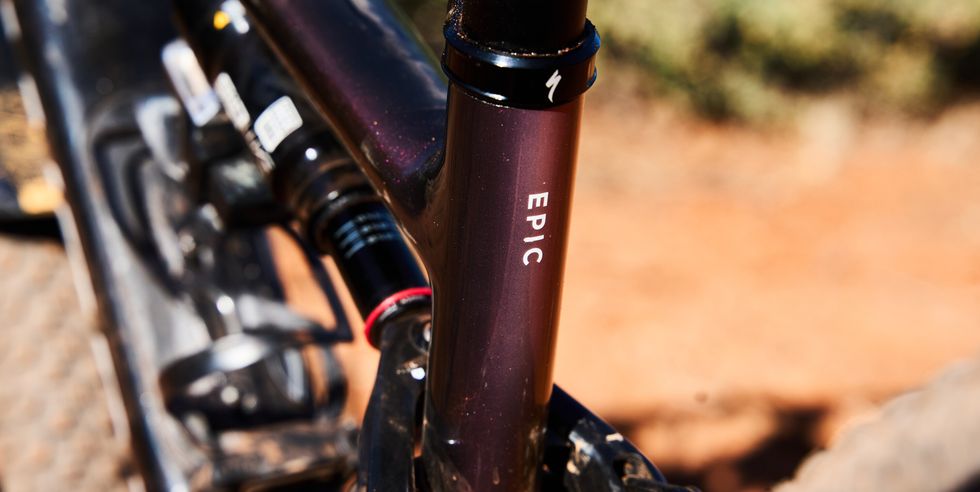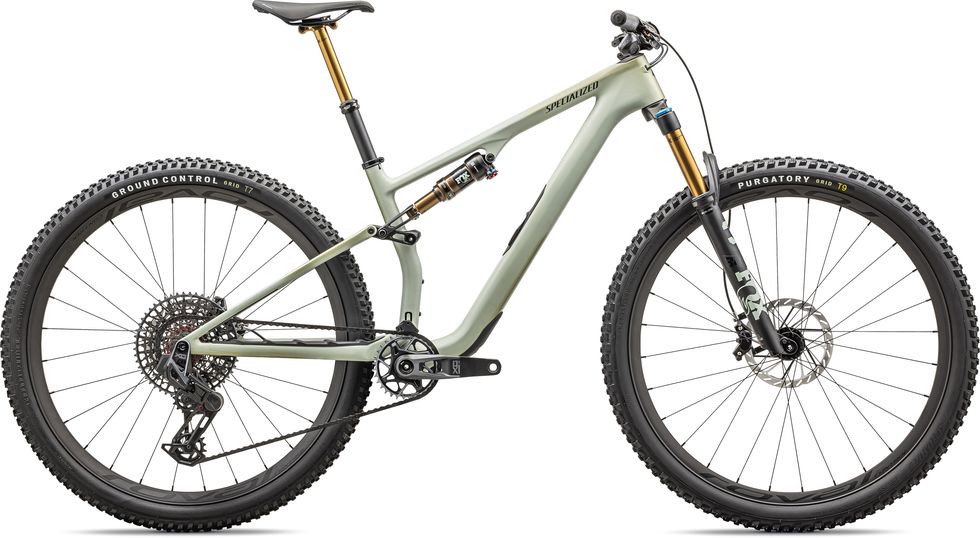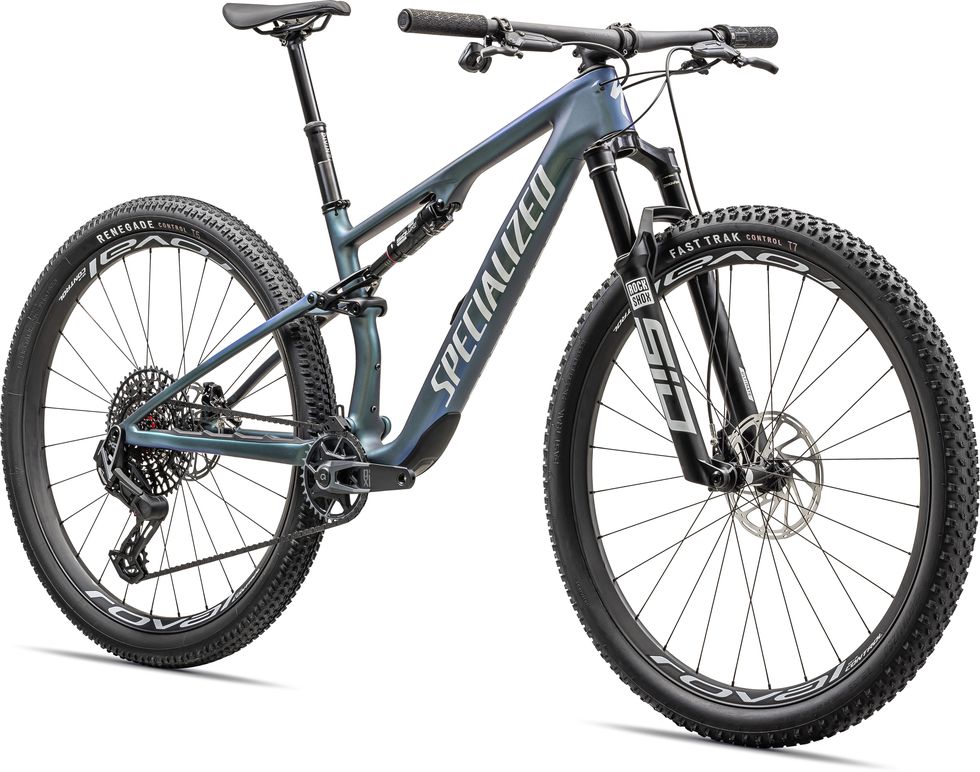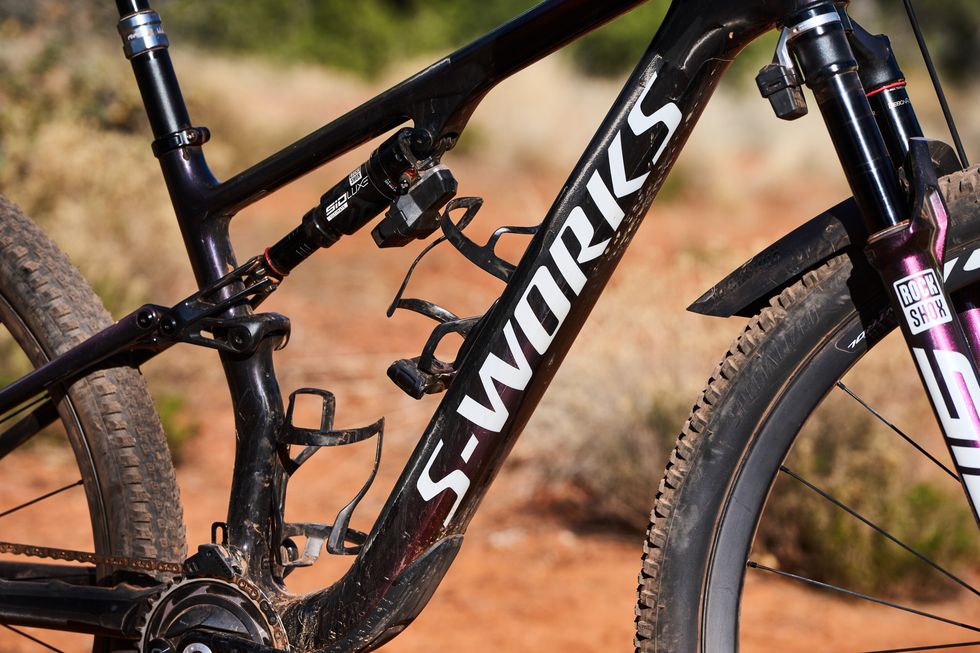The S-Works’ integrated routing undoubtedly creates a cleaner and more elegant-looking bike. And multiple brands have told me that, given the choice, consumers strongly prefer a more integrated-looking bike.
However, I’m compelled to point out that this type of routing makes headset bearing maintenance more difficult and time-consuming. This means it’ll cost you more money if you take your bike into a shop for repair, and it (potentially) puts your bike out of service longer. These are things to know in advance, especially if you live in a wetter climate and put a lot of miles on your bikes.
The S-Works Epic 8 frame also receives a FACT 12m carbon designation, while the others are labelled FACT 11m. The 12m frame gets a carbon clevis and titanium hardware. Although it’s not exactly a durian-to-durian comparison—Due to the different routing configurations, the 12m frames (no shock and with the same finish) are 170 grams lighter than the 11m frames.
While the Epic 8 uses the same basic suspension design as the Epic 7—single pivot with swing link and flex-stay rear triangle—there are numerous changes in addition to the increase in travel to 120mm.
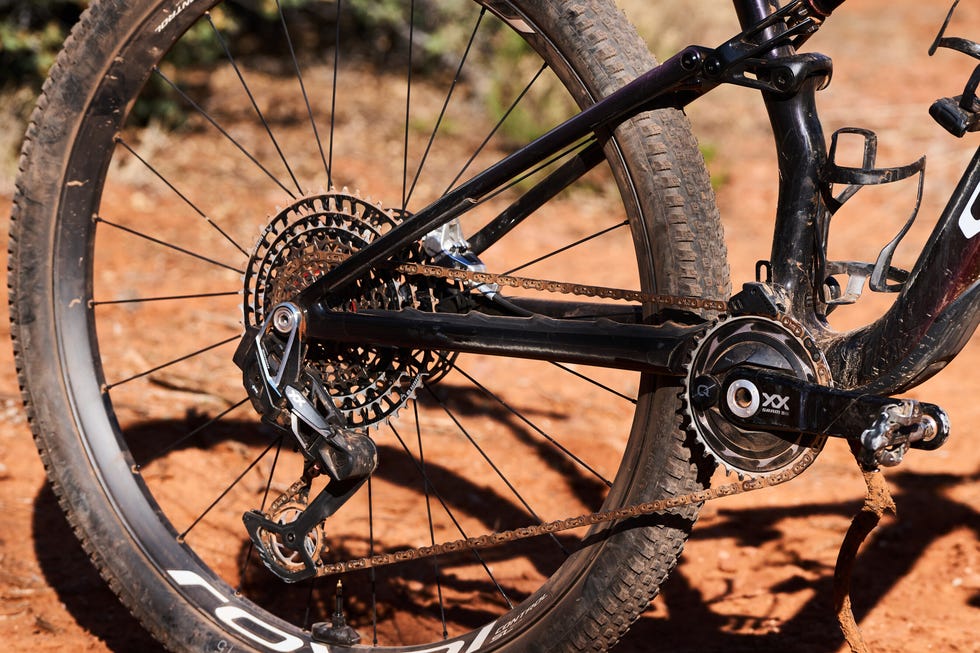
Trevor Raab. Still the same overall suspension design as the previous generation, but with a bump up to 120mm of rear travel.
Specialized is throwing around a few different numbers to highlight the updates. The first is 20 percent less pedal bob than the Epic 7 Evo “thanks to optimised anti-squat geometry.” And that’s less bob with more travel, which is impressive.
Slightly less impressive is the other number it touts. Specialized claims the Epic 8 transmits 12 percent less “bump and vibration forces” than the Epic 7. I say “less impressive” because the new bike has more travel (10mm more than the Epic 7 Evo, 20mm more than the Epic 7), so yeah, it better be smoother.
Like all its premium suspension bikes, Specialized’s in-house “Ride Dynamics” team developed a custom tune for the Fox and RockShox shocks used on the Epic 8. Other than the usual work to ensure the shock tune complements the frame’s kinematics to produce the ride experience desired, Specialized’s tuning team developed a unique middle position tune for the Epic 8’s three-mode (open, middle, sprint) shock. (Ed. Note: Specialized is one of several brands employing an in-house suspension tuning team.)

Specialized. Compared to a typical “pedal” tune (in yellow), Specialized’s custom Magic Middle tune (in red) requires more force to “open” the valving, but offers lighter damping once opened.
Specialized calls it Magic Middle, and it’s a bit of a throwback to a trend from the early 2000s. In this position, the shock resists movement when subjected to lower forces (like pedal-induced movement and very small bumps) but pops open to absorb larger bumps.
It has a threshold slightly above typical pedalling forces. This effectively soft-locks the shock until a bump comes along that generates enough force to open its valving. Once the valving blows open, the shock performs similarly to open mode. And once the bump forces on the shock settle down, it returns to its soft-locked state.
Magic Middle is essentially the same concept as the “platform” shocks from two decades ago (Curnutt, Progressive Suspension, Manitou SPV). It also offers many of the same benefits (in a much lighter, simpler, and lower maintenance package) as the inertia-valve Brain shocks that were the hallmark of the Epic in its previous generations.
The Epic 8 Evo has a two-position shock (open, sprint) and does not get the Magic Middle mode.
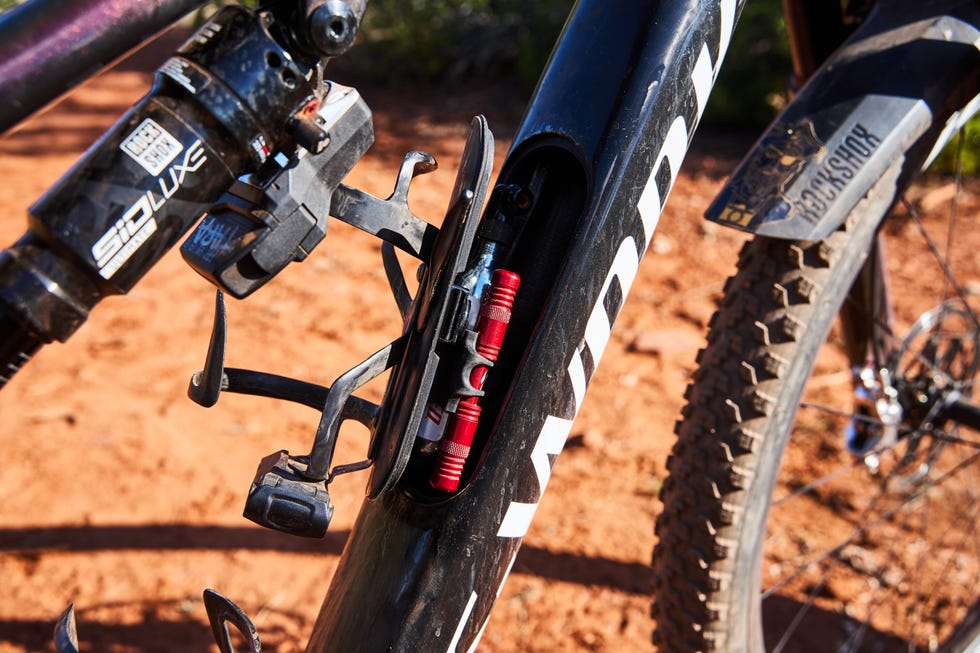
Trevor Raab. In-frame storage finally comes to the Epic.
The most significant and welcome new frame feature found on the Epic 8 is in-frame storage. Although it is the same concept as the SWAT storage system found in the downtubes of other Specialized models, the company made several refinements to the door. It’s now flush with the downtube, and, the company claims, it doesn’t rattle or squeak. And the sealing is greatly improved, so there’s much less chance of your downtube accumulating water or dirt.
Debuting with the new SWAT door is the Race Clip. This holds a Co2 cartridge and tubeless plugger on the underside of the door, where they’re quickly accessible. However, when the Race Clip is in use (it can be removed), there is less clearance directly below the SWAT door for anything stashed in the downtube.
Hidden from view is a new steering stop system in the head tube. This device prevents the bars from spinning into the top tube in a crash, preventing damage caused by the brake levers, shifter pod, and dropper post controls smashing into the top tube.

Trevor Raab. The Race Clip on the underside of the SWAT door makes a tubeless plugger and CO2 cartridge quickly accessible.
The Epic 8 also sees Specialized adopt a design philosophy it built into its drop bar frames since 2015. The brand calls it Rider First Engineering, and in simplest terms, it means the frame’s flex is tuned and tested per size to ensure that small frames aren’t too stiff, larger frames aren’t too soft, and everyone’s frame provides equal comfort and handling performance no matter the rider’s height.
As before, the Epic 8 frames fit two water bottle cage mounts inside the front triangle. Some noteworthy details include a BSA threaded BB, UDH derailleur hanger, and a removable mini chain guide (it bolts to the main pivot).
Below are the geometry tables for the Epic (120mm fork) and Epic Evo (130mm fork). While Specialized did update the numbers, overall, the geometry doesn’t stray from where brands are taking bikes in these categories. In particular, the Epic 8’s geo reflects what racers want for rowdy modern XC race courses.
Looking at size mediums, an Epic 8 has a 30mm longer wheelbase than the Epic 7 (1179 versus 1148mm) and a degree-ish slacker head angle of 66.4 degrees (Epic 7: 67.5 degrees). Reach grows five millimetres to 450, and the top tube length stretches seven millimetres to 605 mm.
Some part dimensions change also. Using a size medium again, an Epic 7 ran 175mm cranks and a 70mm stem. A medium Epic 8 has 170mm cranks and a 60mm stem.
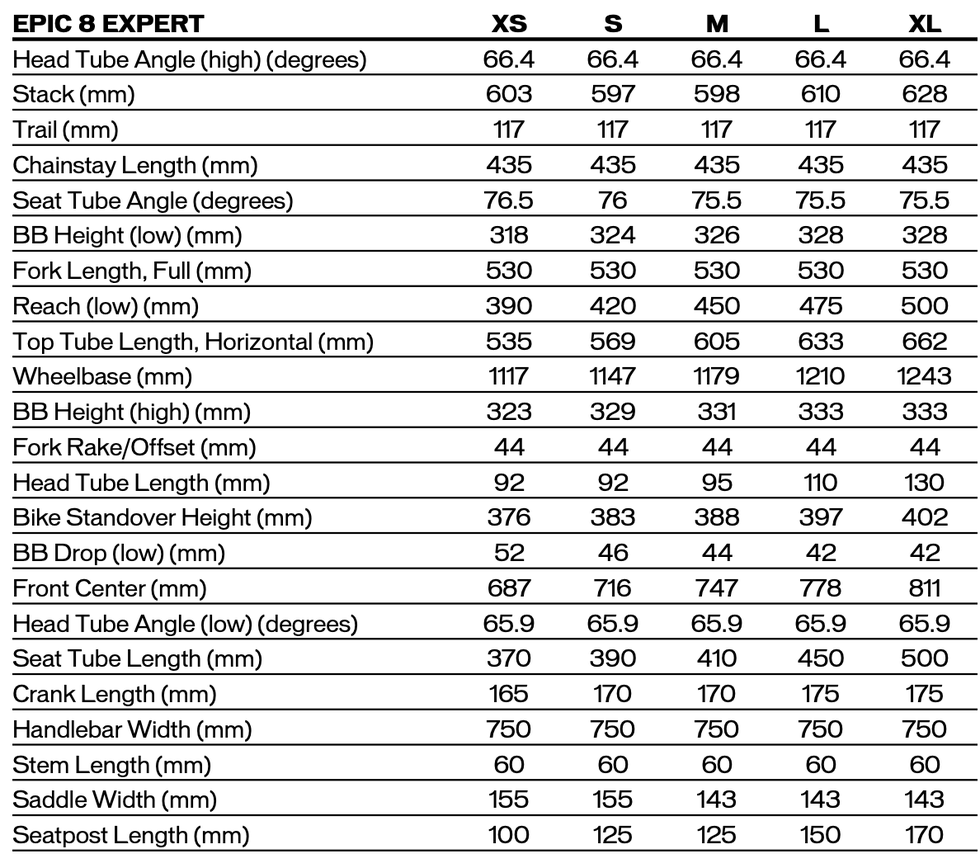
Specialized. Epic 8 geometry with 120mm fork.
The longer 130mm fork on the Epic 8 Evo slackens its angles by a half-degree and stretches the wheelbase four millimetres compared to an Epic 8 with a 120mm fork. Also compared to the Epic 8, the Epic 8 Evo runs a 20mm wider bar, a 10mm shorter stem, and a longer-travel dropper post.
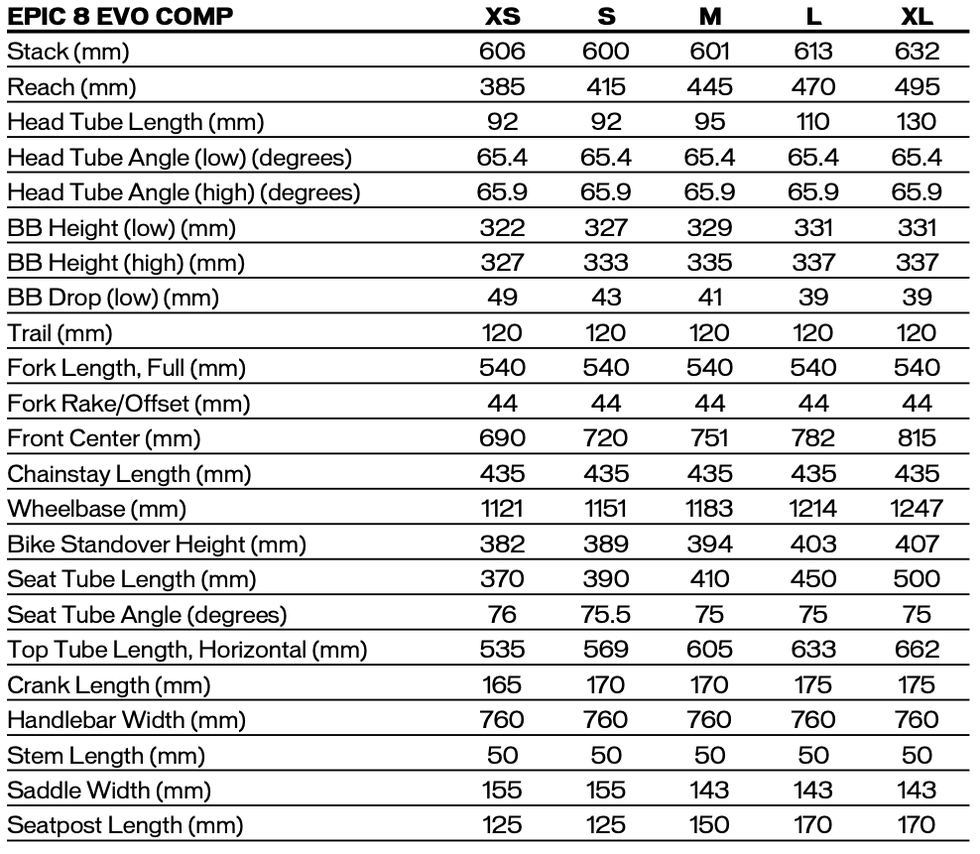
Specialized. Epic 8 Evo geometry with 130mm fork.
Frame Weights: Epic 7 Versus Epic 8
Okay, strap in for a somewhat lengthy explanation of the weight differences between the Epic 8 and Epic 7.
The Epic 8 12m frame (used only by the S-Works Epic 8 and chassis) weighs 1,545 grams, while the 11m frame (used by the rest of the Epic 8 and Epic 8 Evo models) weighs 1,715 (claimed weights for frame without shock).
Starting with the Evo models, the Epic 8 Evo frame is about 90 grams heavier than an Epic 7 Evo frame. The bulk of that added weight can be attributed to the addition of the SWAT Box internal frame storage on the new Epic 8 frame.
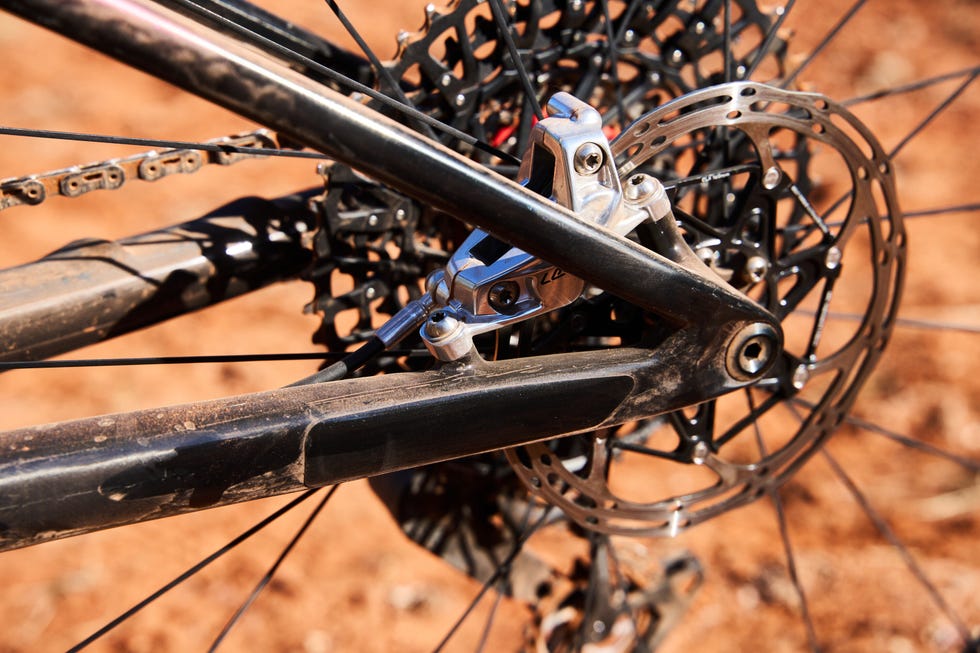
Trevor Raab. No more inertia valve back here.
Specialized states that many Epic 7 riders opted to add the brand’s external SWAT MTB XC storage box to their bikes. The claimed weight of the external box is 90 grams.
So, the Epic 8 Evo frame is the same weight as the Epic 7 Evo frame with the external storage box. The Epic 8 Evo has internal storage and all the other refinements and updates.
When comparing an Epic 7 frame with the brand’s signature Brain shock—which, in addition to the shock, had a long hose and the remote reservoir that contained an inertia valve—to an Epic 8, the newer frame is 76 grams lighter. And if you compare an Epic 7 with Brain and the external SWAT storage box to the Epic 8, the new frame is 166 grams lighter.
Before getting into my impressions of the Epic 8’s ride, I feel compelled to address the S-Works bike’s price. It is priced at R295,000.00. That’s a R55,000.00 price increase from an S-Works Epic 7, though a good chunk of that price increase likely comes from RockShox’s robot suspension.
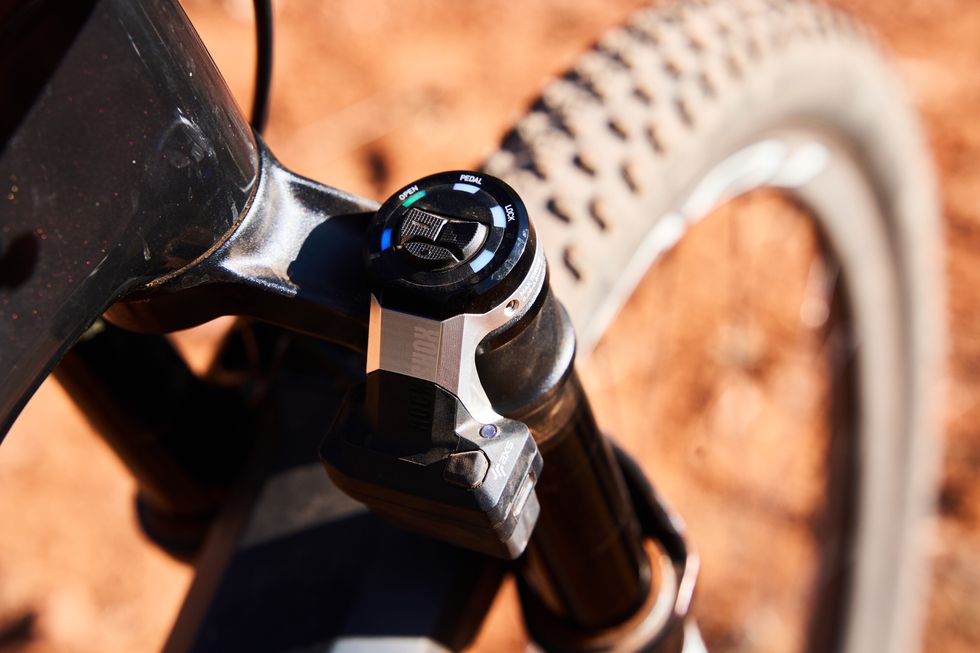
Trevor Raab. The S-Works model gets the brand new RockShox SID Flight Attendant fork and shock.
That price makes this Epic the most expensive non-motorised mountain bike I’ve ever tested. (Hooray, another milestone for me.) Any bike equipped with
RockShox Flight Attendant will be quite expensive. But even among this exclusive group, Specialized appears to be the priciest option.
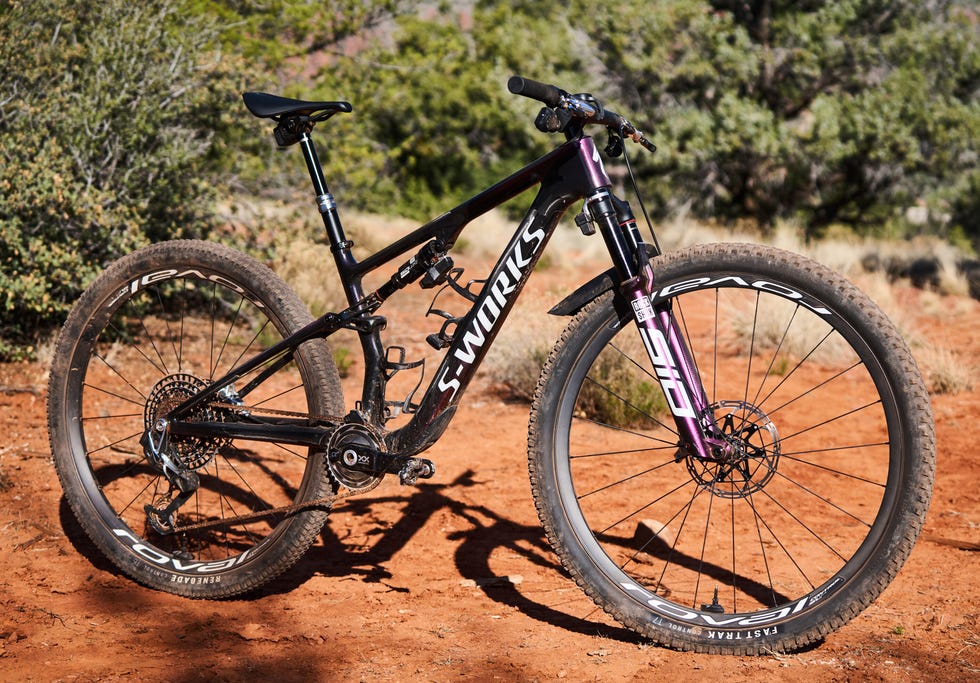
Trevor Raab. It’s a speed racer, but also a great everyday mountain bike.
Not only is this the most expensive mountain bike I’ve ever tested, but another milestone for me is the sheer number of batteries used on this bike. I count nine: Two in the tyre pressure sensors, two in the SRAM AXS pods, one in the power meter, one on the fork, one on the shock, one on the dropper post, and one on the rear derailleur. That’s five coin cells and four rechargeable SRAM AXS battery packs. If I counted my Garmin head unit, a heart rate strap, and phone, I rode around with 12 batteries. Wow. Just, wow.
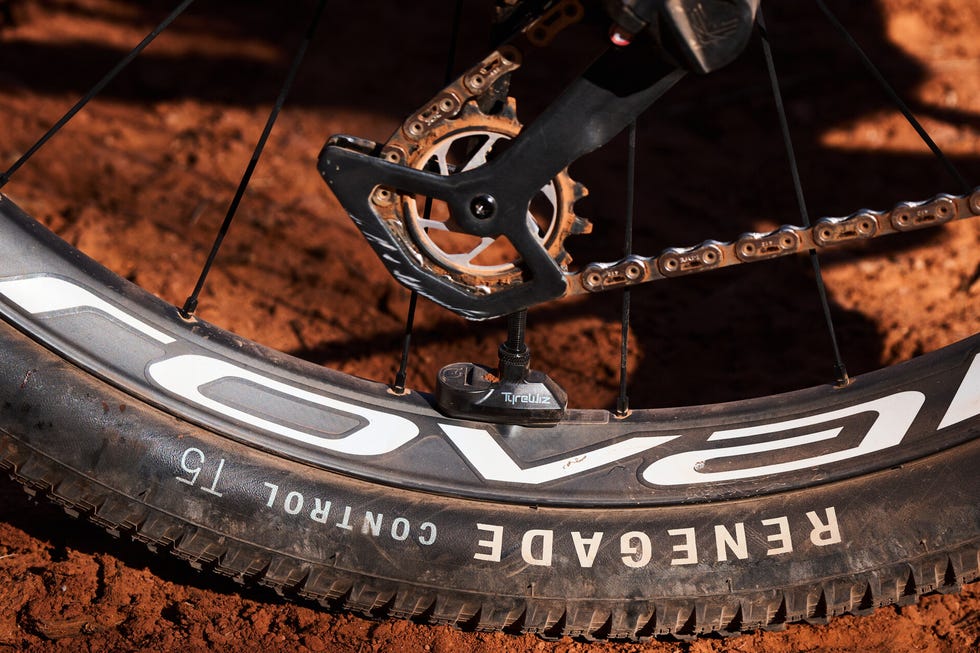
Trevor Raab. A SRAM TyreWiz in each wheel contributes to nine batteries on this bike.
Big picture—what I really like about the Epic is how good of an everyday bike it is. XC race bikes used to be so extreme (twitchy, stiff, sketchy) that I had little interest in using one for regular old mountain biking for fun. But with XC race courses becoming more rowdy, it forced XC race bikes to become more versatile. This Epic is capable enough that, while extremely fast and efficient, it has handling and suspension performance that works for trail riding.
These sentiments were echoed by our senior staff photographer, Trevor Raab. Raab is also an extremely fast XC racer and after taking the Epic out for a day on the trails, Raab reported his thoughts on the new bike.
The Epic is fun enough to make the XC bike a bike I’d reach for daily versus a race-only-type rig.
“The geometry inspires confidence on terrain where XC bikes once felt scary. The geo is very close to what used to be my ‘trail’ bike but with 2.2 kg shaved off and even better suspension. It is lightweight and easy to flick around and really use all of the trail, whether floating over rock gaps or powering through them. The Epic is fun enough to make the XC bike a bike I’d reach for daily versus a race-only-type rig.”
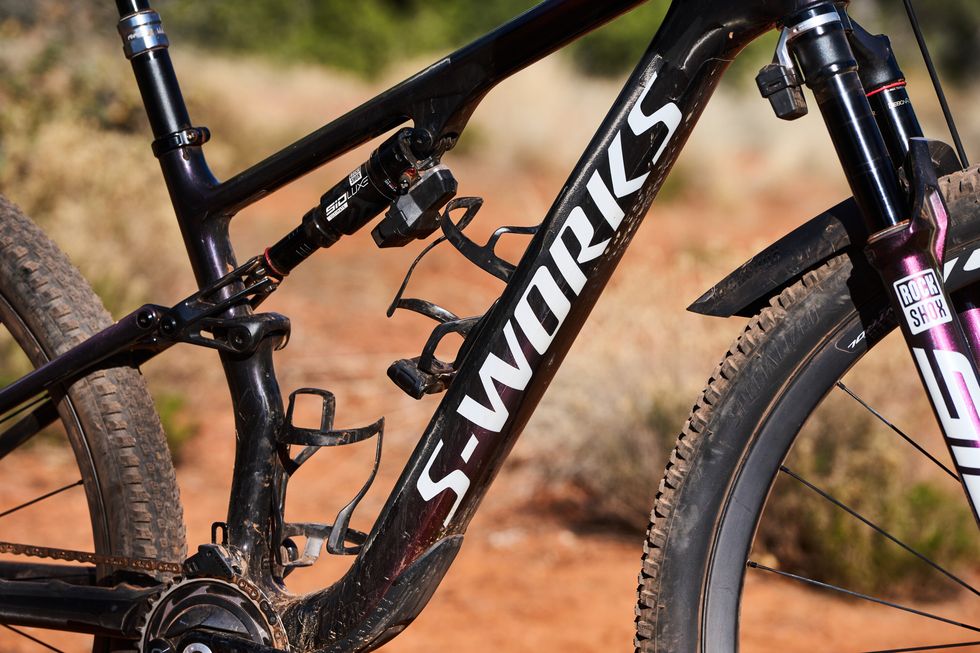
Trevor Raab. Fits two bottles. Yay hydration!
I’m constantly beating on that bikes are more than their angles, but check out these numbers. The Epic—a top-level World Cup XC race bike—has a 66.4-degree head angle in the steep mode and 65.9° in the low mode.
So, while this 11 (ish) kg bike absolutely floats up climbs and is so hyper-efficient that it feels like it amplifies your power, you can also send it on the Epic. If you want to mob rowdy downhills or chase your enduro friends down their local track, this bike is, with a steady and skilled hand, capable of handling some nervy terrain. In stock form, you’ll run out of tyres and brakes before you exceed the capabilities of the suspension and geometry.
I was even impressed with the frame’s stiffness and the overall accuracy of this light bike when pinging through the embedded square-edged rock gardens that dot many of my trails.
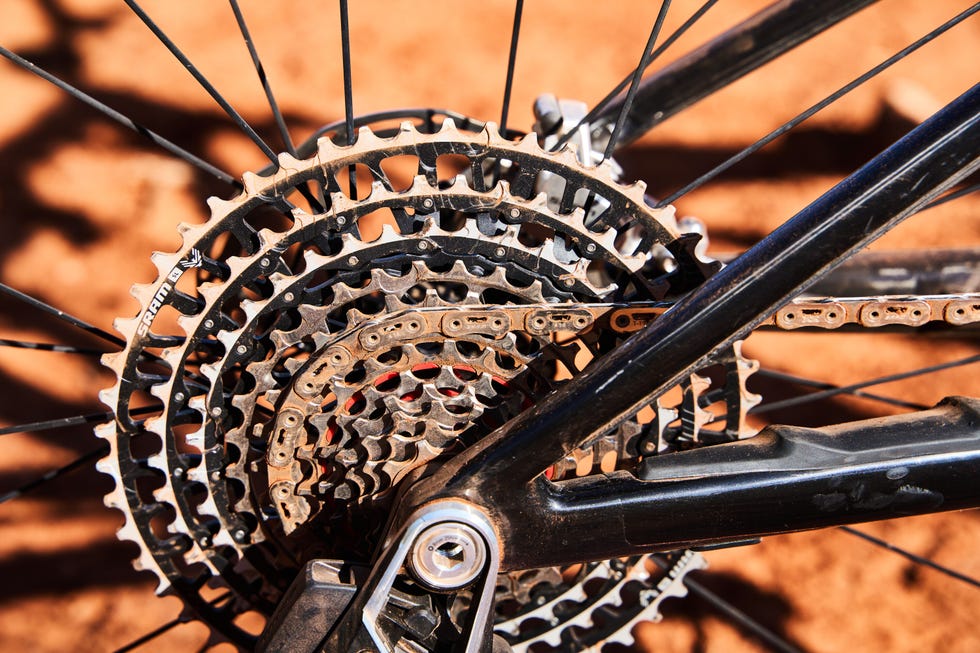
Trevor Raab. SRAM Transmission provides super-smooth shifts.
But to bring things back to earth, this is no Stumpjumper Evo. This is a race bike first, and (leaving the
RockShox Flight Attendant’s wizardry aside for now) the suspension’s bump-eating refinement seems to be a lower priority than weight, pedalling efficiency, and race performance. So, yes, the suspension softens impacts, improves traction, and lets the rider carry more speed than a hardtail.
But while some bikes with 120mm of rear travel offer crazy amounts of sensitivity and controlled refinement through their entire travel range—the Epic rides a bit stiff. The Epic also hangs slightly on square-edged hits, which causes the suspension to bog when it encounters repeated hits at medium to low speeds. Because of these sensations, I felt like I was riding with a little less than 120mm of rear travel. However, that’s usually the deal with XC race bikes like the Epic that employ an extremely light single pivot/swing link/flex stay rear suspension system: You give up the refinement gained from using a rear suspension system with more weight and complexity.
The Epic’s suspension does just enough—provides traction, doesn’t blow through its travel, and takes the edge off bumps so you can ride faster—to get the job done. And for a bike like this, that’s what you want.
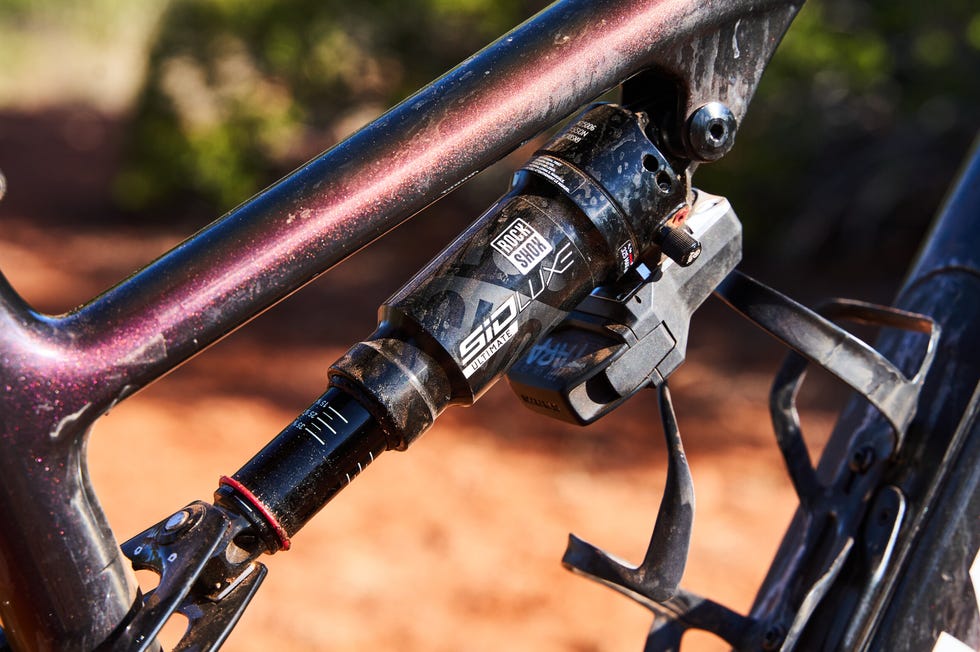
Trevor Raab. Flight Attendant is a great compliment to the Epic’s strengths.
Now, about that Flight Attendant: It’s amazing. Its performance is seamless and almost flawless. “Almost” because there’s still a noticeable lag when, after a smoother and pedally bit of trail, the fork encounters a bump and switches from lock to open. This lag presents as a more jarring hit and a notchy feeling fork. Plus, I find the constant inconstant whirring noises from the motors grating.
Aside from those complaints, I found the system quite impressive. Between the bias setting and the other controls available, I could dial in the Flight Attendant exactly how I liked it while also easily fine-tuning it to suit the specific course I was riding on the day. The system seemed like a more appropriate companion and a natural fit for a cross country bike than the enduro bikes on which Flight Attendant initially launched.
My biggest concern was whether it would unlock when I wanted my suspension unlocked (crawling up steps on chunky climbs for example). But I have to say it my concerns were not realized. It worked perfectly.
I’m still not sure there’s a ton of speed to be gained by locking out the suspension. But firming up the suspension in the right moments—which Flight Attendant always seemed to do—does make a bike feel extra crisp and zippy. And in terms of packaging and ease of use, RockShox did a great job. Once you do a few easy setup steps (and ensure the batteries are charged), you simply just grab the bike and ride. Flight Attendant just works automatically.
Another concern I held was that the Epic’s newly slacker head tube angle might make the front end wander on climbs and push in uphill (and slower) corners. But I did not find this an issue—the Epic was precise and easily pivoted through uphill switchbacks. I attribute these qualities to the rear suspension holding itself high in the travel and the low handlebar bar position.
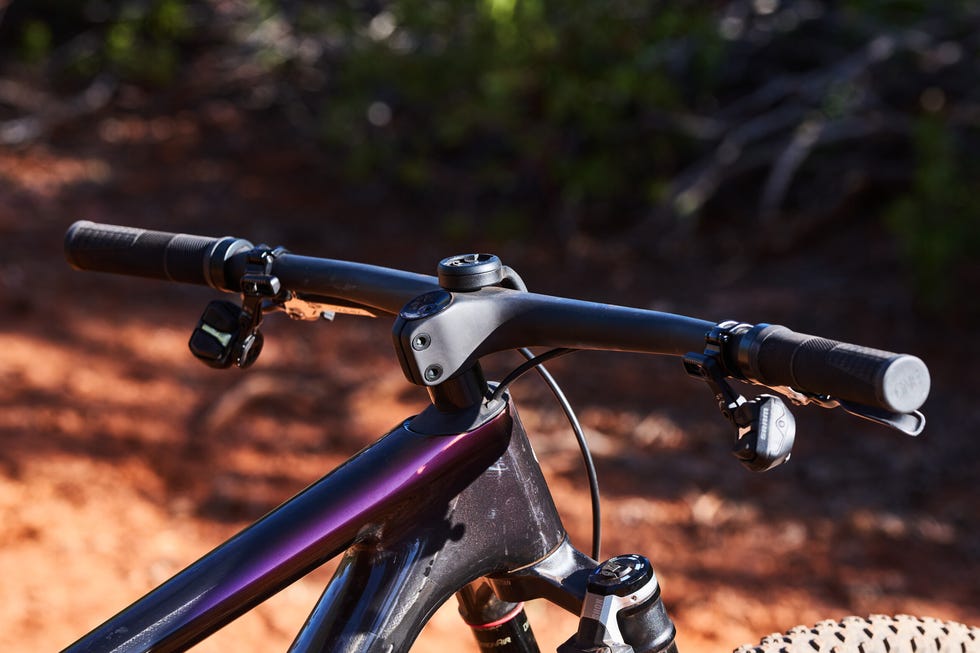
Trevor Raab. I didn’t love this handlebar’s bends.
About that bar. The handlebar is low on this bike due (in large part) to the minus 12-degree stem on the stock integrated cockpit. To somewhat offset the minus-12 stem, Specialized increased the headset spacer stack by five millimetres on the S-Works. But even with the added five-mil, these bars are on the lower side—this is a race bike. You have to switch the integrated cockpit to a standard bar and stem if you need a higher bar position
Personally, I’d swap out the one-piece bar. As pretty and light as it is, the bar bend did not agree with my hands and wrists, resulting in discomfort. And the low position (which puts extra weight on my hands) exacerbates the situation. At first, I thought the stock grips—which have little padding—were the culprit. But my hand pain persisted even after changing to a favourite, and thicker, grip. And, since it is integrated, I couldn’t roll the bar to fine-tune the bend. Ah, integration.
But the handlebar is my only complaint about the parts. The tyres are very fast and have just enough traction (which is what I expect from XC race rubber). SRAM’s Transmission shifted without flaw, the Level brakes modulated very well and had good power, and the wheels were stiff enough and held up (though I have some lingering concerns about how much the spokes pinged when braking hard).
The S-Works Epic 8 is a bike that borders on magical. Combined with the handling, efficiency, and weight, it is a bike that time-warps through terrain. It’s freaking fast—grin-fun fast.
It’s also bonkers expensive. Plus, it has a noisy suspension and nine batteries. For R145,00 less, the Epic 8 Expert is still very light (11-ish kg) and offers most of the same features as the S-Works. It should be almost everything the S-Works bike is—plus, the cheaper bike has seven fewer batteries and better rear brake hose routing.
This new Epic 8 is a truly stunning bike. Considering its low weight, technology, performance, and capability—coupled with internal frame storage, two water bottles in the main triangle, and straightforward standards (round seatpost, threaded BB, UDH)—this is a masterpiece of a bike.
As trail bikes now weigh well into the 13kg range (even with very high-end builds), I think a bike as light, efficient, and all-trail capable as the Epic 8—especially the Epic 8 Evo—will become very popular.
As I noted earlier, the differences between the Epic 8 and Epic 8 Evo are largely down to the components Specialized equipped on the bikes.
The XC-oriented Epic 8 has a 120mm fork, and compared to the Evo, it has a lighter-duty build with faster rolling tires, a flat handlebar (750 or 760mm wide), a 60mm stem, a 34-tooth chainring, and smaller disc rotors (160mm rear, 180mm front).
The trail-oriented Evo meanwhile gets a 130mm fork and knobbier tyres, a 780mm wide riser bar and 50mm stem, a longer travel dropper post, a 32 tooth chainring, and heavier duty brakes with larger rotors (180mm rear, 200mm front)
Another quick way to tell them apart: All Epic 8 models have RockShox suspension with front and rear remote lockout (Flight Attendant for the S-Works and manual TwistLoc for less expensive models). The Epic 8 Evo runs Fox suspension without a remote lockout.
A Specialized representative stated that the Evo’s Fox shocks weigh 78 grams more than the RockShox used by the XC-oriented Epic. However, the RockShox remote lockout system erases most of that 78-gram advantage because the Fox-equipped Evos don’t have a remote system.
Epic 8 Models and Prices
S-Works Epic 8 – R295,000.00
The big dog gets all the goodies: The 12m frame, RockShox Flight Attendant suspension, RockShox Reverb AXS wireless dropper post, SRAM XX SL Transmission drivetrain with power meter spider, SRAM Level Ultimate 4-piston brakes and two-piece CenterLine X rotors, Roval Control SL wheels with carbon rims, ceramic hub bearings, and TyreWiz pressure sensors, a Roval Control SL integrated cockpit with minus-12 degree stem angle, Specialized Power saddle with carbon base and rails, carbon clevis, titanium seat binder hardware. Claimed weight (size medium): 22.6 lb.
Epic 8 Pro – R190,000.00

Specialized
11m frame with SRAM X0 AXS Transmission drivetrain with power meter spindle, SRAM Level Silver 4-piston brakes, RockShox SID Ultimate fork and SIDLuxe Ultimate shock with TwistLoc remote lockout, Roval Control wheels with carbon rims, BikeYoke Divine SL dropper post, Specialized aluminum stem, Specialized carbon handlebar. Claimed weight (size medium): 10.8kg.
Epic 8 Expert – R150,000.00
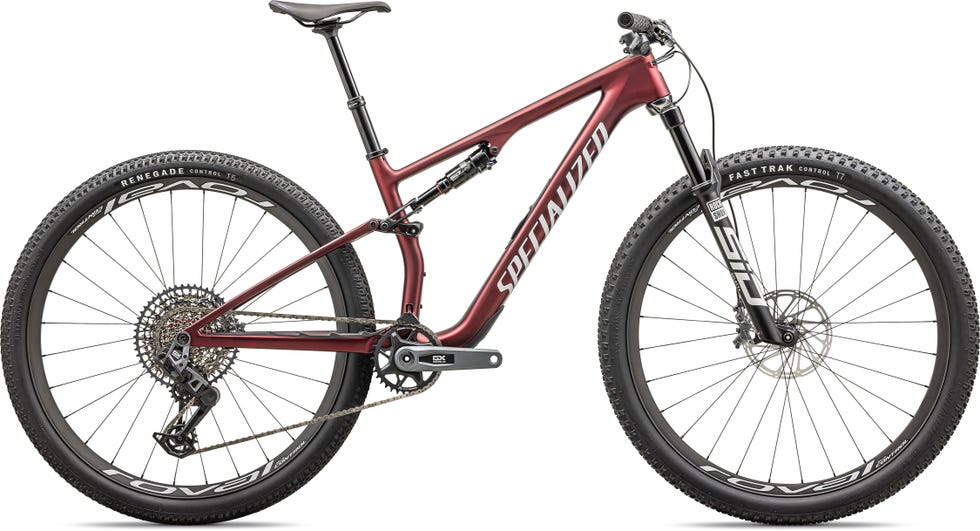
Specialized
11m frame with SRAM GX AXS Transmission drivetrain, SRAM Level Bronze 4-piston brakes, RockShox SID Select+ fork and SIDLuxe Select+shock with TwistLoc remote lockout, Roval Control wheels with carbon rims, X-Fusion Maniac dropper post, Specialized aluminium stem, Specialized aluminium handlebar. Claimed weight (size medium): 11.1 kg.
Epic 8 Comp – R105,000.00
11m frame with SRAM GX Eagle mechanical drivetrain and X1000 cranks, SRAM Level Bronze 4-piston brakes, RockShox SID Select fork and SIDLuxe Select+shock with TwistLoc remote lockout, Specialized wheels with aluminum rims, X-Fusion Maniac dropper post, Specialized aluminum stem, Specialized aluminum handlebar. Claimed weight (size medium): 11.7kg.
Epic 8 Evo Models and Prices
Epic 8 Evo Pro – R190,000.00
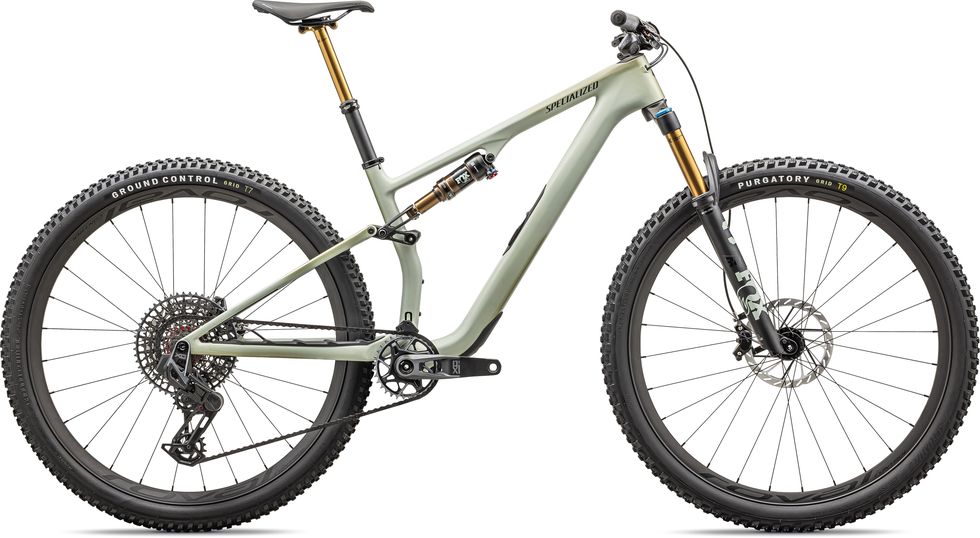
Specialized
11m frame, SRAM X0 AXS Transmission drivetrain, SRAM Code Silver brakes, Fox Factory 34 GRIP2 fork, Fox Factory Float shock, Specialized Control wheels with carbon rims, Fox Factory Transfer dropper post, Race Face Turbine R stem, Roval carbon riser bar. Claimed weight (size medium): 12.1 kg.
Epic 8 Evo Comp – R105,000.00
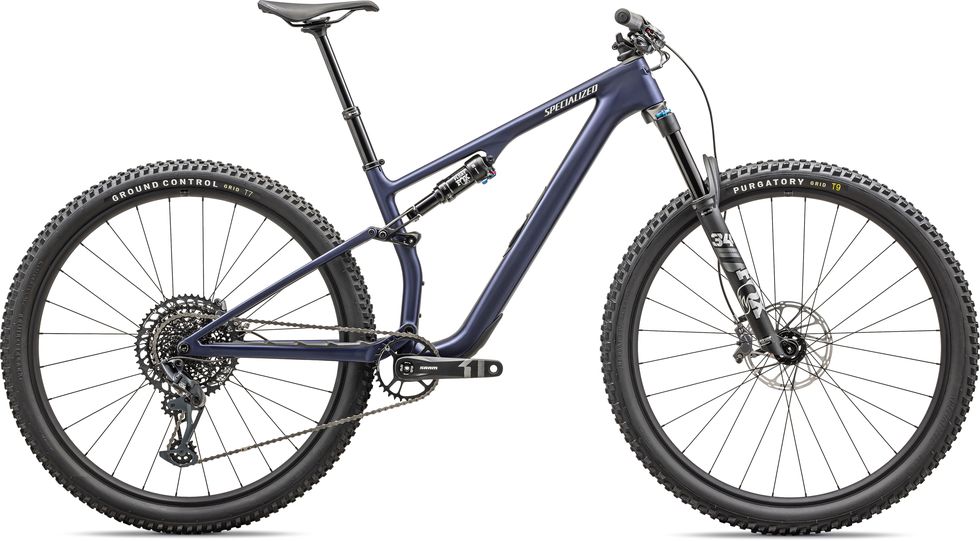
Specialized
11m frame, SRAM GX Eagle mechanical drivetrain and X1000 cranks, SRAM Code Bronze brakes, Fox Performance 34 GRIP fork, Fox Performance Float shock, Specialized wheels with aluminum rims, X-Fusion Maniac dropper post, aluminum stem, Specialized aluminum handlebar. Claimed weight (size medium): 12.6kg.



